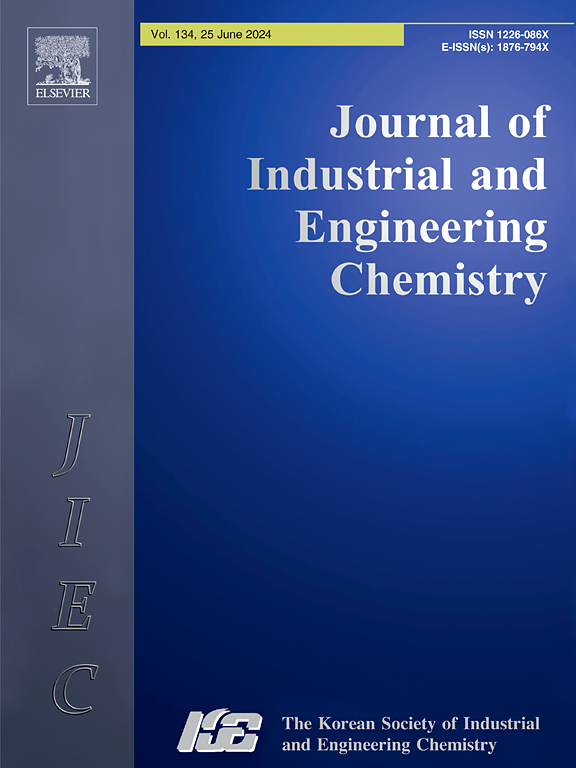Synergistic two-step modification of polybenzimidazole (PBI) nanofiltration membranes for improved molecular separation in acidic and organic environments
IF 5.9
3区 工程技术
Q1 CHEMISTRY, MULTIDISCIPLINARY
Journal of Industrial and Engineering Chemistry
Pub Date : 2025-07-20
DOI:10.1016/j.jiec.2025.07.048
引用次数: 0
Abstract
This study presents a time-efficient, two-step modification strategy to significantly enhance polybenzimidazole (PBI) membrane resistance to acids and organic solvents, targeting low-pH aqueous and organic solvent nanofiltration (OSN) for industrial applications. A green solvent-based aqueous Fenton reaction pretreats the membrane, improving chemical and thermal stability via enhanced chain interactions. Subsequent Thiol-Ene click chemistry crosslinking introduces crucial flexibility, compensating for Fenton-induced brittleness. This synergistic PBI-FT membrane demonstrates remarkable stability in 70 % HNO3 (maintaining > 80 % MgSO4 rejection) and highly polar aprotic solvents (DMAc, DMF, NMP), retaining > 97 % weight. In OSN, PBI-FT achieved 2.1 LMH/bar ethanol permeance with > 97 % Rose Bengal rejection, showing superior separation even after 168 h DMF exposure. This sustainable technique yields robust nanofiltration membranes for efficient separation processes in challenging industrial environments.聚苯并咪唑(PBI)纳滤膜的两步协同改性以改善酸性和有机环境中的分子分离
本研究提出了一种省时、两步的改性策略,以显著提高聚苯并咪唑(PBI)膜对酸和有机溶剂的抗性,针对工业应用中的低ph水和有机溶剂纳滤(OSN)。绿色溶剂基水性芬顿反应预处理膜,通过增强链相互作用提高化学和热稳定性。随后的硫醇-烯点击化学交联引入了关键的柔韧性,补偿了芬顿引起的脆性。这种增效PBI-FT膜在70% % HNO3(保持 >; 80 % MgSO4的截除率)和高极性非质子溶剂(DMAc, DMF, NMP)中表现出显著的稳定性,保持 >; 97 %的重量。在OSN中,PBI-FT达到2.1 LMH/bar的乙醇渗透率, >; 97% %的玫瑰拒除率,即使在168 h的DMF暴露后也显示出优越的分离效果。这种可持续的技术产生强大的纳滤膜,在具有挑战性的工业环境中进行有效的分离过程。
本文章由计算机程序翻译,如有差异,请以英文原文为准。
求助全文
约1分钟内获得全文
求助全文
来源期刊
CiteScore
10.40
自引率
6.60%
发文量
639
审稿时长
29 days
期刊介绍:
Journal of Industrial and Engineering Chemistry is published monthly in English by the Korean Society of Industrial and Engineering Chemistry. JIEC brings together multidisciplinary interests in one journal and is to disseminate information on all aspects of research and development in industrial and engineering chemistry. Contributions in the form of research articles, short communications, notes and reviews are considered for publication. The editors welcome original contributions that have not been and are not to be published elsewhere. Instruction to authors and a manuscript submissions form are printed at the end of each issue. Bulk reprints of individual articles can be ordered. This publication is partially supported by Korea Research Foundation and the Korean Federation of Science and Technology Societies.

 求助内容:
求助内容: 应助结果提醒方式:
应助结果提醒方式:


